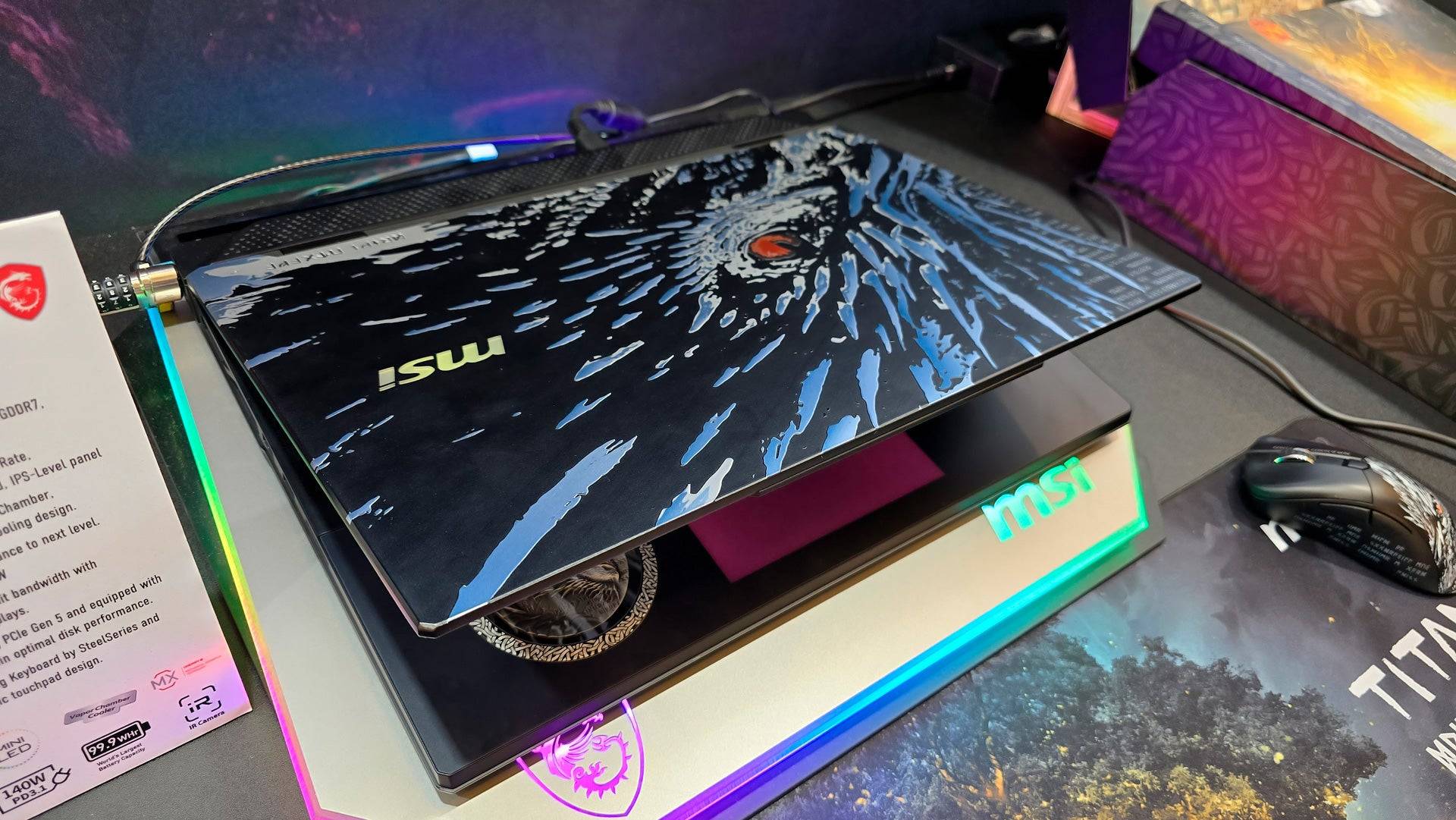CES 2025 Unveils Latest Gaming Laptop Trends
CES never disappoints when it comes to showcasing the latest in laptops, and this year's event was no different. I explored the expansive show floor and various packed suites and showrooms to uncover the dominant trends shaping gaming laptops for this year. Here are the key themes that emerged in the world of gaming laptops at CES.
A Huge Diversity of Designs
Gaming laptops have always varied in style, but this year's designs felt particularly diverse. This trend is driven by brands like Gigabyte and MSI, which are increasingly blending productivity with gaming aesthetics. There's also a push for high-end gaming laptops to offer something beyond just powerful hardware.
Expect a broader range of gaming laptops this year. For instance, the Gigabyte Aero series boasts a sleek, professional look that blends seamlessly into business environments. On the other hand, the MSI Titan 18 HX AI Dragonforged Edition proudly displays bold graphics on its lid, signaling its gaming prowess to onlookers.
 RGB lighting remains a staple, with innovations like wrap-around lighting rings, illuminated mechanical keyboards, and even trackpad lights. The Asus ROG Strix Scar series stood out with its AniME Dot Matrix LED display, capable of showing text and animations via white LEDs on the lid.
RGB lighting remains a staple, with innovations like wrap-around lighting rings, illuminated mechanical keyboards, and even trackpad lights. The Asus ROG Strix Scar series stood out with its AniME Dot Matrix LED display, capable of showing text and animations via white LEDs on the lid.
While the designs aren't necessarily groundbreaking, the variety ranges from bulky powerhouses to sleek, lightweight models, catering to a wide array of preferences and hardware needs.
 AI Assistants are Coming
AI Assistants are Coming
Last year, AI was touted as a key feature in many laptops, but the integration often fell short. This year, multiple vendors previewed AI Assistants designed to enhance user interaction by allowing control of the PC without needing to manually open software.
In one demonstration, an MSI representative used a chatbot to specify a desired game type, prompting the assistant to automatically adjust the performance settings to match the game's intensity. While these systems are intended to operate offline, I remain skeptical about their efficiency compared to manual adjustments. We'll need to see how these features perform in real-world scenarios.
Mini-LED, Rollable Displays and Other Novelties
Mini-LED technology is finally gaining traction in gaming laptops. Brands like Asus, MSI, and Gigabyte showcased Mini-LED models with top-tier specs and prices. These displays, featuring over 1,100 local dimming zones, offer reduced blooming, increased contrast, and vibrant colors. While OLED still excels in contrast, Mini-LED's lack of burn-in risk and higher sustained brightness make it a promising contender.
Additionally, there were several innovative features on display. The ASUS ROG Flow X13, returning after a year's hiatus, now supports eGPUs via USB4, eliminating the need for proprietary connections. Asus also showcased a new eGPU product compatible with up to an RTX 5090.
 Elsewhere, Asus presented its Zenbook Duo, a dual-screen productivity laptop. However, Lenovo stole the show with the ThinkBook Plus Gen 6 Rollable, the first laptop to feature a rollable OLED display. With a simple button press, the 14-inch screen expands by an additional 2.7 inches. While the initial design may seem awkward and concerns about durability linger, it's a pioneering product that's set to improve as technology advances.
Elsewhere, Asus presented its Zenbook Duo, a dual-screen productivity laptop. However, Lenovo stole the show with the ThinkBook Plus Gen 6 Rollable, the first laptop to feature a rollable OLED display. With a simple button press, the 14-inch screen expands by an additional 2.7 inches. While the initial design may seem awkward and concerns about durability linger, it's a pioneering product that's set to improve as technology advances.
Ultrabooks Continue to Rise, Even for Gaming
Ultrabooks are increasingly popular, even within gaming line-ups. Major manufacturers now offer thin, light, and premium gaming laptops, with Gigabyte's revamped Aero series exemplifying this trend.
These ultrabooks are perfect for gamers who don't need to run the latest games at max settings. They offer portability and productivity, as evidenced by my review of the Asus TUF Gaming A14 last year, which showed that even ultrabooks can handle dedicated graphics without compromising their on-the-go functionality.
 Moreover, with the latest AMD and Intel processors, even integrated graphics can deliver a decent gaming experience. Technologies like AMD FidelityFX Super Resolution and Intel XeSS, combined with frame generation, enable relatively demanding games to be playable. This raises questions about the necessity of low-end dedicated graphics like the RTX 4050M.
Moreover, with the latest AMD and Intel processors, even integrated graphics can deliver a decent gaming experience. Technologies like AMD FidelityFX Super Resolution and Intel XeSS, combined with frame generation, enable relatively demanding games to be playable. This raises questions about the necessity of low-end dedicated graphics like the RTX 4050M.
Cloud gaming services such as Xbox Cloud Gaming and Nvidia GeForce Now further enhance the appeal of these ultrabooks, allowing for a quality gaming experience without a dedicated "gaming" laptop.
The gaming laptop landscape at CES was brimming with exciting developments. We'll continue to cover these trends throughout the year. What caught your eye? Share your thoughts in the comments below!
- 1 Holiday Thief Arrives in Seekers Notes Dec 26,2024
- 2 Jujutsu Kaisen Phantom Parade: Tier List Update for 2024 Dec 28,2024
- 3 How To Find and Beat the Storm King in LEGO Fortnite Jan 05,2025
- 4 PUBG Mobile's Championship Finale Nears Jan 09,2025
- 5 Goddess Of Victory: Nikke Is Dropping a New Year’s Update and Collabs with Evangelion and Stellar Blade Soon Jan 04,2025
- 6 Brok's Festive Adventure Now Available Jan 03,2025
- 7 Blue Archive introduces new story event with the Cyber New Year March Jan 05,2025
- 8 Skibidi Toilet DMCAs Garry's Mod But Legitimacy Remains Unclear Jan 07,2025
-
Mastering the Art of Digital Tools
A total of 10
-
Hidden Gems: Unexpectedly Useful Other Apps
A total of 10
-
Top Free Adventure Necessary Games for Android
A total of 4














![LeMOMnade: Family Squeeze! – Version 1.1.1 [mtrellex]](https://img.3xbz.com/uploads/38/1719569762667e8d62c486e.jpg)



![My Cute Roommate 2 – New Version 1.0 Extra [Astaros3D]](https://img.3xbz.com/uploads/38/1719606486667f1cd652f1a.jpg)











